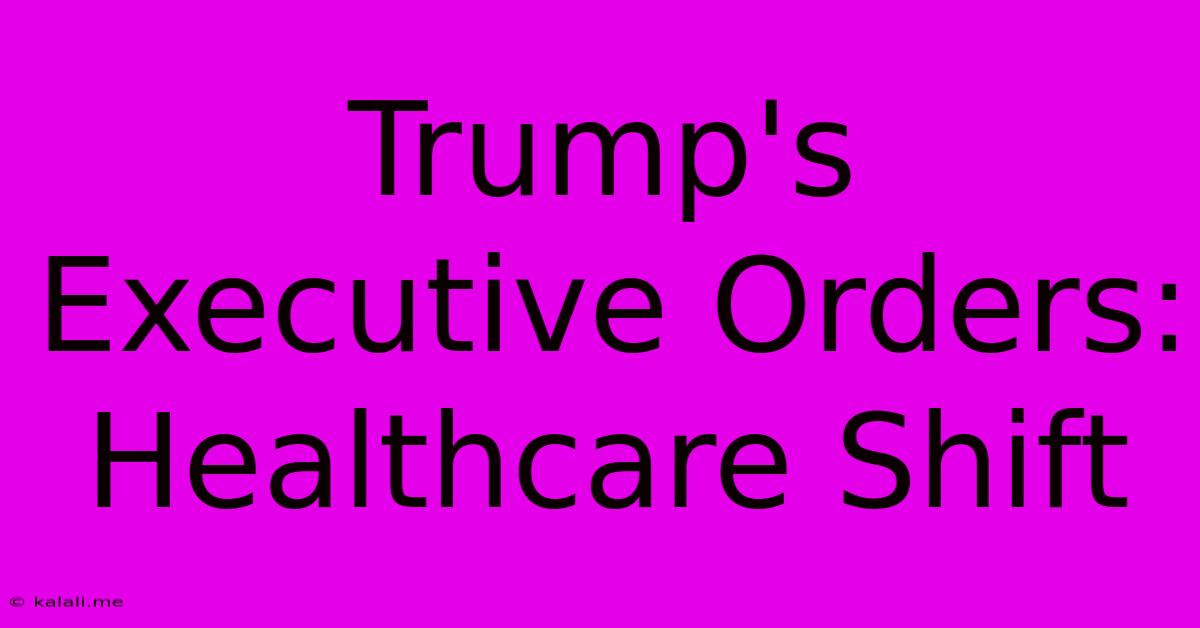Trump's Executive Orders: Healthcare Shift
Kalali
Jan 26, 2025 · 4 min read

Table of Contents
Trump's Executive Orders: A Seismic Shift in Healthcare
Donald Trump's presidency witnessed a series of executive orders aimed at dramatically reshaping the American healthcare landscape. These actions, often met with fierce opposition and legal challenges, reflected a core campaign promise: to dismantle and replace the Affordable Care Act (ACA), also known as Obamacare. While the complete replacement never materialized, Trump's executive orders left a significant mark on healthcare policy, impacting access, affordability, and the role of the federal government. This article delves into the key executive orders, their intended effects, their actual impact, and the lasting consequences on the American healthcare system.
Key Executive Orders and Their Objectives
Trump's healthcare agenda, largely driven by executive action, focused on several key areas: deregulation, increasing access to cheaper insurance alternatives, and weakening the ACA. Let's examine some of the most impactful orders:
Executive Order 13795: Promoting Healthcare Choice and Competition Across the United States
This order, issued in October 2017, aimed to expand the availability of association health plans (AHPs) and short-term, limited-duration insurance (STLDI). The core argument was that these less regulated plans would offer more affordable options to consumers.
- Intended Effect: Increase competition, drive down premiums, and offer more choice to individuals and small businesses.
- Actual Impact: The expansion of AHPs and STLDI led to concerns about consumer protection. Critics argued that these plans often lacked comprehensive coverage, including essential health benefits mandated by the ACA, potentially leaving consumers vulnerable to high out-of-pocket costs in case of serious illness. Legal challenges ensued, further complicating the rollout.
Executive Order 13813: Protecting and Improving Medicare and Medicaid for Our Nation's Seniors and Most Vulnerable
Issued in April 2018, this order targeted administrative burdens on healthcare providers, particularly within Medicare and Medicaid. The goal was to streamline regulations and reduce administrative costs, ostensibly freeing up resources for patient care.
- Intended Effect: Simplify administrative processes, reduce paperwork for providers, and ultimately lower healthcare costs.
- Actual Impact: The impact was mixed. While some administrative burdens were reduced, the extent to which this translated into lower healthcare costs for consumers remains debated. The long-term effects of this executive order on Medicare and Medicaid remain to be fully assessed.
Efforts to undermine the ACA through regulatory changes:
While not strictly executive orders, the Trump administration pursued numerous regulatory changes aimed at weakening the ACA. This involved altering the rules governing the individual insurance market, including reducing funding for outreach and enrollment assistance. These actions were intended to destabilize the ACA marketplaces, potentially leading to higher premiums and reduced coverage.
- Intended Effect: Undermine the ACA's success, encouraging its repeal or replacement.
- Actual Impact: These actions contributed to uncertainty in the individual insurance market, impacting both enrollment and the availability of plans in some areas. However, the ACA ultimately survived these efforts, demonstrating a degree of resilience.
The Broader Context: Political and Legal Battles
Trump's executive orders on healthcare were highly contentious, facing significant opposition from Democrats and various healthcare advocacy groups. These actions ignited heated political debates, centering on the role of government regulation, the importance of universal healthcare access, and the potential consequences of deregulation.
The legal challenges were equally substantial. Several states and advocacy groups filed lawsuits challenging the legality of the executive orders, particularly those concerning AHPs and STLDI. These legal battles added further uncertainty to the healthcare landscape, delaying implementation and sometimes resulting in court rulings that overturned or limited the scope of certain actions.
Long-Term Consequences and Lasting Legacy
While the Trump administration's complete overhaul of the ACA never materialized, its efforts left a lasting imprint on the American healthcare system. The expanded access to less regulated insurance plans raises ongoing concerns about consumer protection and the quality of care. The attempts to undermine the ACA, while unsuccessful in fully dismantling it, undeniably created instability and uncertainty in the market.
The long-term consequences remain to be fully understood. The impact on healthcare costs, access to care, and the future of healthcare reform in the United States will continue to unfold in the years to come. The debate surrounding the appropriate balance between government regulation, market forces, and individual responsibility in healthcare will undoubtedly persist. Analyzing the Trump administration's approach is crucial for informing future healthcare policy discussions and ensuring the ongoing pursuit of a more equitable and efficient healthcare system.
Conclusion: A Legacy of Disruption and Debate
Trump's executive orders on healthcare represent a significant chapter in the ongoing debate over the direction of American healthcare policy. While aiming for significant reform, these actions ultimately fell short of their ambitious goals, leaving a legacy of disruption and lingering questions. The impact of these policies, both intended and unintended, will continue to be analyzed and debated for years to come, informing the ongoing struggle to achieve a healthcare system that balances affordability, accessibility, and quality of care for all Americans. The efforts to reshape the healthcare landscape through executive action highlight the complexities and controversies inherent in healthcare reform and the crucial need for thoughtful, comprehensive approaches to address the challenges facing the American healthcare system.
Latest Posts
Latest Posts
-
Spyware Can Result In All Of The Following Except
Jul 05, 2025
-
What Year Were 16 Year Olds Born
Jul 05, 2025
-
Two Letter Symbol From The Periodic Table
Jul 05, 2025
-
How Long Will It Take To Walk 5 Miles
Jul 05, 2025
-
How To Beat Stage 9 On Bloxorz
Jul 05, 2025
Related Post
Thank you for visiting our website which covers about Trump's Executive Orders: Healthcare Shift . We hope the information provided has been useful to you. Feel free to contact us if you have any questions or need further assistance. See you next time and don't miss to bookmark.